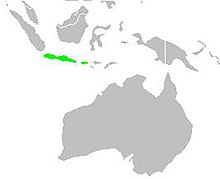Rice finch
| Rice finch | ||||||||||||
|---|---|---|---|---|---|---|---|---|---|---|---|---|

Rice finch ( Lonchura oryzivora ) |
||||||||||||
| Systematics | ||||||||||||
|
||||||||||||
| Scientific name | ||||||||||||
| Lonchura oryzivora | ||||||||||||
| ( Linnaeus , 1758) |
The rice finch ( Lonchura oryzivora , syn .: Padda oryzivora ), also called rice amadine or rice nun , is a species of the finch family . No subspecies are distinguished. Together with the Timor rice finch , the rice finch was for a long time attributed to its own genus Padda ( rice finch ). Recent molecular genetic studies have shown that this group of two species is phylogenetically located within the genus of the bronze male ( Lonchura ) and is closely related to the nutmeg bronze male there .
Appearance
The rice finch has a body length of 14 centimeters. The plumage on the top of the body and the chest is blue-gray. The top of the head and the uppermost part of the throat are black; the large white patches on the cheek and the very strong beak are striking. The beak is two-colored. The top and bottom of the beak are bright red, while the beak sheaths are lighter in color and the beak tip is whitish. The eyes are brown and surrounded by a bright red ring.
There is no pronounced gender dimorphism . The safest way to distinguish between females and males is that only the male sings.
Young birds are dark gray on the top and yellowish gray on the underside of the body. Their beak is black and the edge of the eyelid is yellowish gray. The feet are flesh-colored.
Distribution area
The rice finch was originally only found in Java and Bali as well as Bawean . Today it is native to many tropical countries and comes, among others, in Calcutta , Madras , Hong Kong , Miami and Bangkok , on Sumatra , Hawaii , the Moluccas , Malaysia including Singapore , on the Fiji Islands Viti Levu and Vanua Levu , in the Philippines , in southern Indochina and Taiwan . Populations also live on the East African coast and on Zanzibar and St. Helena . While it is quite rare in its original range in Java and Bali, human distribution has ensured survival as a species in the past. In recent times the population has declined catastrophically, so a study in 64 places where rice finches were known to occur found only 109 individuals in 17 places. The total population is estimated at only 1000-2500 and is heavily fragmented. The popularity of the rice finch as a cage bird is the main reason for the drastic decrease in the population. The IUCN classifies the species as endangered .
Way of life
The habitat of the rice finch includes light forests with large areas of grass and cultivated land. It can often be seen on the outskirts and along paths. The messy looking and spherical nest is built in dense shrubbery, in tree hollows and under roofs. The clutch consists of four to seven eggs that are incubated by both adult birds. The young hatch after 13 to 14 days and are usually sexually mature after five to six months.
Rice finches live on grass seeds and grain. They could invade rice and grain fields in large swarms and there ate the grains from the panicles.
Rice finch and human
The rice finch is a traditional caged bird that has been kept in cages and aviaries in China and Japan for centuries . The time when the birds were first introduced into Europe is not known. It is believed that the birds were brought back by seafarers for the first time at the end of the 18th century. The French ornithologist Vieillot describes them as a generally popular species at the beginning of the 19th century. However, domestication features are not as pronounced as would be expected after centuries of keeping in Asia and Europe. This is probably due to the fact that, due to the frequent imports of wild-caught birds, they were repeatedly crossed into the breeding line of the ornamental birds. However, a leucistic form of culture has been known from China and Japan for centuries. It is certain that birds were introduced several times after 1860.
supporting documents
literature
- Horst Bielfeld : Knowing and caring for 300 ornamental birds. Ulmer Verlag, Stuttgart 2009, ISBN 978-3-8001-5737-2 .
- Jürgen Nicolai (Ed.), Joachim Steinbacher (Ed.), Renate van den Elzen, Gerhard Hofmann: Prachtfinken - Australia, Oceania, Southeast Asia . Eugen Ulmer Verlag, Stuttgart 2001, ISBN 3-8001-3249-4 .
- Peter Clement , Alan Harris, John Davis: Finches and Sparrows. An Identification Guide. Christopher Helm, London 1993, ISBN 0-7136-8017-2 .
Web links
- Lonchura oryzivora in the endangered Red List species the IUCN 2008. Posted by: BirdLife International, 2008. Accessed January 2 of 2009.
Single receipts
- ↑ Antonio Arnaiz-Villena, Valentin Ruiz-del-Valle, Pablo Gomez-Prieto, Raquel Reguera, Carlos Parga-Lozano and Ignacio Serrano-Vela: Estrildinae Finches (Aves, Passeriformes) from Africa, South Asia and Australia: a Molecular Phylogeographic Study . In: The Open Ornithologist Journal . tape 2 , 2009, p. 29-36 , doi : 10.2174 / 1874453200902010029 ( mec.es [PDF]).
- ↑ Nicolai et al., P. 205
- ↑ Nicolai et al., P. 205 and p. 206
- ↑ a b Nicolai et al., P. 209

